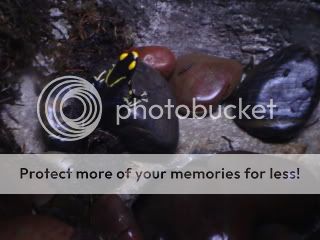M.R Otter
Fishaholic
Common name: Poison dart frog, Poison arrow frog, dyeing poison frog
Scientific name: Dendrobates tinctorius.
Family: Dendrobatidae.
Origin: Native to Central and South America, Brazil,
Tank size: 20 gallon .
Care: Poison dart frogs are not too easy to keep but do best if the right environment is created for them. The tank should recreate the frog's natural habitat as it is in the wild. To keep the frogs thriving you need to keep the tank's humidity at 80-100% and temperature around 22-27c. You can mist the frogs if needed. This species is one of the larger dart frogs. The tank should contain water so that the frog can cool off. Change it weekly to prevent stagnation unless the water is moving.
Feeding: In the wild the Poison dart frog feeds on ants, centipedes and mites. In captivity they will accept any small live bug but try to keep it under 1/4" long. It is also advisable that you use tweezers when feeding these frogs. These frogs DO use their poison to catch prey but captive bred poison dart frogs do not contain a high amount of poison.
Sexing: There is no easy way to sex poison dart frogs but it is reported that females are slightly bigger than the males in the breeding season. Another method is to note the footpads which are larger in the male.
Breeding: The frogs have a fascinating way to care for their young: the parent will take the little tadpole and carry it on it's back. It then climbs trees in search of pools of water that accumulate in the bromeliads. The female then will add infertile eggs in the tadpoles diet. In captivity, one recommended method of breeding is to place half a coconut shell in the tank, increase the humidity and lengthen the night interval.
Comments: Keep the poison dart frog away from the reach of children as even captive bred frogs have some amount of poison that could be harmful to kids.
Here is a picture of a poison dart frog in captivity

Scientific name: Dendrobates tinctorius.
Family: Dendrobatidae.
Origin: Native to Central and South America, Brazil,
Tank size: 20 gallon .
Care: Poison dart frogs are not too easy to keep but do best if the right environment is created for them. The tank should recreate the frog's natural habitat as it is in the wild. To keep the frogs thriving you need to keep the tank's humidity at 80-100% and temperature around 22-27c. You can mist the frogs if needed. This species is one of the larger dart frogs. The tank should contain water so that the frog can cool off. Change it weekly to prevent stagnation unless the water is moving.
Feeding: In the wild the Poison dart frog feeds on ants, centipedes and mites. In captivity they will accept any small live bug but try to keep it under 1/4" long. It is also advisable that you use tweezers when feeding these frogs. These frogs DO use their poison to catch prey but captive bred poison dart frogs do not contain a high amount of poison.
Sexing: There is no easy way to sex poison dart frogs but it is reported that females are slightly bigger than the males in the breeding season. Another method is to note the footpads which are larger in the male.
Breeding: The frogs have a fascinating way to care for their young: the parent will take the little tadpole and carry it on it's back. It then climbs trees in search of pools of water that accumulate in the bromeliads. The female then will add infertile eggs in the tadpoles diet. In captivity, one recommended method of breeding is to place half a coconut shell in the tank, increase the humidity and lengthen the night interval.
Comments: Keep the poison dart frog away from the reach of children as even captive bred frogs have some amount of poison that could be harmful to kids.
Here is a picture of a poison dart frog in captivity



